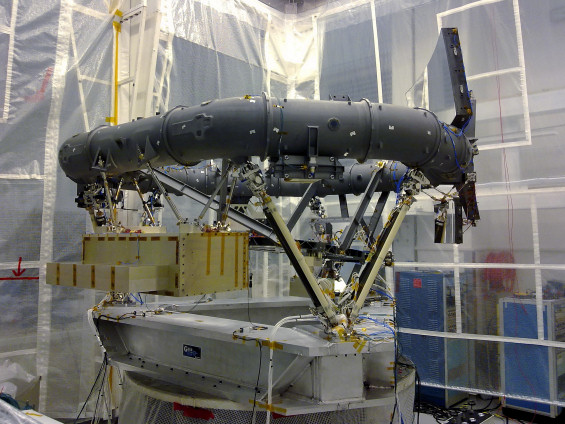#01: Payload Module vibration testing completed
23 August 2011
This is the first entry in the Gaia Test Campaign Journal, a series of articles covering the main events during the integration and testing of the Structural Model (SM) and the Proto-Flight Model (PFM) of the Gaia spacecraft. The journal is expected to run until the completion of PFM testing; shortly after this, the Gaia Launch Campaign Journal will begin.In late June, mechanical testing of the Gaia Payload Module was performed at the facilities of Intespace in Toulouse, France, under the direction of the Prime Contractor, Astrium. The results have been analysed and the testing declared successfully completed.
 |
|
The Gaia Payload Module in the Intespace facility. Videos of the test can be accessed via the link on the right-hand menu, or by clicking here (for the Z-axis test) or here (for the X-axis test). |
In order to verify the mechanical properties of the payload module and to prove that it can survive the launch, it was subjected to swept-sine and quasi-static load tests using an electrodynamic shaker. During swept-sine testing, the shaker excites the test subject with sinusoidal movements along the axis of interest at a slowly changing (two octaves per minute) frequency. Quasi-static testing simulates the effects of static loads on the structure by vibrating it at very low frequencies (well below the eigenfrequencies of the test subject).
The primary structural component of the Gaia Payload Module is the optical bench, also known as the 'torus', which is constructed from 19 sintered silicon carbide components brazed together. The flight torus was mounted onto the test adapter on the shaker by its three flight model bipods. To allow verification of the optical alignment, the
The Payload Module was fitted with accelerometers at critical locations to monitor its behaviour during the vibration tests. The swept-sine and quasi-static tests were performed on each of the module's three axes. Swept-sine testing was conducted at three levels: a low level survey (0.1g, swept from 2 kHz down to 0 Hz) which constitutes a reference test allowing unexpected frequency shifts or amplification changes to be detected; an intermediate level sweep (-3 dB referenced to qualification levels, swept down from 100Hz); and finally a sweep down from 100 Hz at qualification levels. The qualification levels varied from 0.2g to 3.5g, depending on the axis under test and the frequency. The excitation amplitude was notched (reduced) at the eigenfrequencies of the Payload Module, to prevent the structure from being subjected to forces not representative of the flight loads and beyond its design limits. When this was done, care was taken to ensure that the loads experienced during the test were still sufficient to match those expected during the launch.
Before the commencement of testing and after the completion of testing on each of the three axes, the optical alignment of the
Philippe Gare, ESA's Gaia Payload Module Manager, expressed his satisfaction that the testing had been satisfactorily completed, explaining that a major programmatic risk had now been retired – in that, had the testing revealed any inadequacies in the first build, a new torus would have had to be manufactured.
About Gaia
Gaia will create a three-dimensional map of the Milky Way, in the process revealing information about its composition, formation and evolution. The mission will perform positional measurements for about one billion stars in our Galaxy and Local Group with unprecedented precision, together with radial velocity measurements for the brightest 150 million objects. Gaia is scheduled to launch in 2013 for a nominal five-year mission, with a possible one-year extension.
The spacecraft will operate in a Lissajous orbit around the second Lagrange point of the Sun-Earth system (L2). This location in space offers a very stable thermal environment, very high observing efficiency (since the Sun, Earth and Moon are all behind the instrument field-of-view) and a low radiation environment. Uninterrupted mapping of the sky will take place during the operational mission phase.
The Prime Contractor for Gaia is Astrium SAS, based in Toulouse, France.



